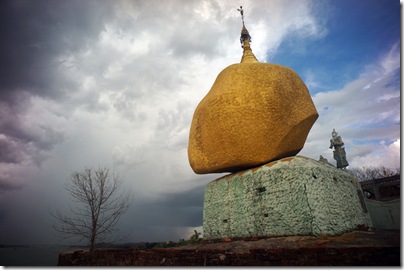There are temples and pagodas EVERYWHERE in Myanmar. You can't cycle more than a few kilometers without seeing a golden (or formerly golden) spire jutting out from somewhere in the landscape. Sometimes there's just a single pagoda, about 5m or so tall, probably built by a local rich person to gain merit before his death. Other times, there's a huge pagoda complex, and then there's the giant Buddha and Bagan, which we'll get to next.
 | |
 |  |
 |  |
We were lucky enough to arrive in Pye, a sizeable town a few hundred kilometers north of Yangon, on the weekend of a full moon festival. The entire area around Pye's immense temple was packed with people; dancing, wearing silly costumes, praying, lounging about, selling food, being drunk, dumping water on the bodi tree, whatever. It was the most irreverent religious festival I've ever seen.
 |  |  |
 |  |  |
 |  |  |
 |  |  |
Then we stopped for a couple days in Bagan. More than just a town, Bagan is a veritable field of temples, 4000 of them strewn across the landscape, so large in area that we had to get up each morning at sunrise to explore by bike. Some of the temples and pagodas are immense, ornate, and grand, others small and crumbly, some in the middle of a haphazard repair job, but all together, they make for an insightful look into the past, where a king could enslave thousands of people over a long period of time to build religious structures that would gain merit for him so he could have a better start in the next life. Like the pyramids of the east. How is one supposed to feel about this? I suppose it's great that these tremendous structures are still here for our viewing benefit, but wouldn't it have been better if all of those people who built these things had just had regular jobs, gotten paid, and had enough to eat? Whatever, it was fun climbing around on these things with all the shakies, watching sunsets/rises, and reflecting on my own inability to procure immortality through financial expenditure.
 |  |  |
 |  |  |
 |  |  |
 |  |  |
 |  |  |
 |  |  |
 |  |  |
We also hit up Monywa, home of both the largest standing and reclining Buddhas in the world. Much taller than the Statue of Liberty, you can see the standing Buddha looming in the distance from more than 10km away. Once you get into the temple complex, you see that there are thousands of man-sized Buddha statues all over the place, as well as more Buddhas inside the big Buddhas. Inside of reclining Buddha's butt, you'll find scary necro-Buddha, as well as mini necro-Buddha. BTW, the inside of Buddha's butt smells like jasmine.
Like Bagan, this was all really cool to see and everything, but it seems like the huge amount of money to construct all this (in 2008 I think? Fairly recently at any rate) could have been better spent on something else, like economic development, clean water, medical facilities, etc, etc. And now that these huge Buddhas have been built, people from all over Myanmar will flock to this place to donate (waste?) money to gain merit for themselves. Or maybe at least some of that money will be used by the local monks for community service projects or whatnot. One can only hope.
 |  |  |
 |  |  |
 |  |  |
 |  |  |
 |  |  |
Speaking of monks...it does seem that monastic life in Myanmar serves to perform a lot of social welfare functions. Monks take alms in the morning, children are sent to temples for education, elderly people go to temples to receive food and participate in religious events, and temples also seem to serve as community centers. We'd often see local people just hanging around at temples and pagodas, flying kites, playing games, or just talking to each other. In particular, they seem to be a place for young people to hang out away from their parents. More than once we visited a pagoda in the middle of a town to find groups of teenagers sitting on the marble floor, boys and girls separate but risking shy glances at each other. And once we camped in a temple, and within minutes the entire village showed up to bring us food, stare at us, watch us eat, and shake our hands repeatedly.
 |  |
 |  |
 |  |
 |  |
 |
Whatever one's own judgments of Myanmar's audacious version of Buddhism is, it is certainly one of the most visually distinctive aspects of what is mostly a very rural, pastoral society, one in which the temples are often the largest and most ornate buildings around.
